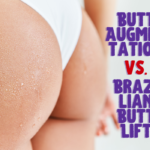Hey there, gorgeous people! ✨ Let’s talk about noses! Yes, those prominent bumps on our faces can play a big role in our confidence. If you’ve ever dreamt of a nose that perfectly complements your features, then rhinoplasty (a nose job) might be on your mind. It’s one of the most popular cosmetic surgeries, and for good reason. It can seriously transform your whole face, bringing everything into a beautiful balance. But wait before you hit up Dr. Miami (just kidding…kinda ), there’s a crucial decision to make which rhinoplasty type fits for you: open rhinoplasty vs. closed rhinoplasty.
Hold on, what’s the difference?

Don’t worry, this article will be your BFF, guiding you through the maze and helping you pick the perfect match for your unique needs 💁♀️
The Great Incision Showdown: Nose Job Types
Open Rhinoplasty: More Visibility, More Control
Imagine a tiny incision hidden right under the tip of your nose, between your nostrils. The surgeon makes a small incision on the columella (the strip of tissue separating your nostrils) to fully expose the underlying bone and cartilage. This rhinoplasty type allows the surgeon a clear view of all the nasal structures, like bone and cartilage. Think of it as lifting the hood of a car to get a good look at the engine or to put it more girlishly it’s like having a full backstage pass to your nose!
This extra access allows the surgeon to precisely sculpt and reshape your nose for more dramatic changes.
Here’s when open rhinoplasty type might be your bestie:
- You desire significant reshaping, like reducing a bump, refining a wide tip, or straightening a deviated septum.
- You’ve had previous rhinoplasty and need revision surgery.
- You have complex cases like major bumps, crooked noses, or nasal structures requiring intricate adjustments.
Do you need more visualization ? Check this video👇
Closed Rhinoplasty: Less Blood, Faster Recovery
Think of closed rhinoplasty as a magician pulling a perfect nose out of a hat (without the actual hat, of course!). The surgeon makes hidden incisions inside your nostrils, making the procedure less invasive. This means no visible scars on the outside of your nose – major win! While closed rhinoplasty type offers a quicker recovery, visibility is slightly limited compared to the open approach. Which means, the surgeon has a slightly limited view. So, this technique is typically used for subtler changes, like refining the tip or smoothing out a minor bump.
Closed rhinoplasty might be your match if:
- You only need minor adjustments, like smoothing a small bump or refining the tip.
- You prioritize minimal scarring and a faster recovery.
- Your nasal structure is relatively straightforward.
If you would like to get more information about rhinoplasty surgery from the American Society of Plastic Surgeons, click here to watch the video.
OK, BUT which rhinoplasty type is right for me?🤦

Deciding Your Rhino Type: Choose Your Champion!
First of all first things first, it’s all about YOU!!
So, which technique reigns supreme? The truth is, there’s no one-size-fits-all answer. The best approach depends on your specific goals, anatomy, and desired outcome. Here’s what you should discuss with your board-certified facial plastic surgeon:
Recovery: Expect some swelling and bruising for the first few weeks. Think of your nose as a work in progress – it takes time to reveal its final masterpiece!
Your aesthetic desires: Be clear about your goals, whether it’s achieving a more balanced look or improving breathing function.Dreaming of a dramatic change? Open rhinoplasty might be the type to go. For tweaks and minor adjustments, closed rhinoplasty could be a good option.
Your medical history: Any past surgeries or medical conditions can influence the choice of technique.
Your nasal anatomy: Some noses are naturally more complex. An experienced surgeon can assess your specific situation and recommend the best approach.
Scarring concerns: If you’re super worried about visible scars, closed rhinoplasty type might be more appealing. But remember, even open rhinoplasty scars are tiny and fade significantly over time.
Realistic expectations: Rhinoplasty can enhance your natural beauty, but it won’t magically transform you into your favorite celebrity. Plus besides, don’t be shy babygirl! Ask your surgeon a million questions (seriously, that’s their job!). Discussing your goals and concerns will help them recommend the most suitable rhinoplasty type for your dream nose.
And again remember, choosing a skilled and experienced surgeon is paramount! Look for board certification and a portfolio showcasing results that align with your aesthetic preferences.
Trusting Your Rhinoplasty Doctor: Tips on Finding the Right Doct
But wait, there’s more!🫢 Here’s what to expect after your rhinoplasty, regardless of open vs. closed:

Unspoken truth-Pain: Although I wish with all my heart that the whole process would be painless and carefree, like a fairy tale, unfortunately, there are some facts we need to talk about: Pain. Pain will be inevitable, as after every incision procedure. However, the important thing here is to reduce the pain as much as possible and increase your comfort. You may want to take a look at our post here to better understand and get through the painful process that may occur after the surgery.
Results: Patience is key! It can take up to a year for all the swelling to subside and for your final results to shine through ✨
Bonus: Frequently Asked Rhinoplasty Questions (FAQs) ❓
1. When can I shower after rhinoplasty?
Your surgeon will give you specific instructions, but generally, you can shower a 1 week after surgery, avoiding direct water pressure on your nose.
2. When to expect stitches removal after rhinoplasty?
The time it takes to remove the stitches may vary depending on the type of stitches that are dissolvable or non-dissolvable and your body’s healing reaction. The most important point here is to follow your doctor’s word and the time of your appointments. To understand the types of stitches and learn more about the stitch removal process and healing process, click here
3. Does open rhinoplasty leave scars?
While open rhinoplasty involves an external incision, it’s carefully placed and usually fades significantly over time.
4. How many times can I get revision rhinoplasty?
The number of revision surgeries can vary, but it’s crucial to choose an experienced surgeon for the best possible outcome the first time around. Check our Revision Rhinoplasty post(link).
5. How do I know if I need revision rhinoplasty?
If you’re unhappy with your initial rhinoplasty results or experience breathing difficulties, consult a board-certified facial plastic surgeon to discuss revision options.
Also, you may want to visit here to learn more about age restrictions for nose surgery.
**Remember, there’s no one-size-fits-all approach to rhinoplasty. The best technique depends on your unique case and goals. Do your research, prioritize your well-being, and choose a surgeon who inspires confidence. By working closely with a qualified and experienced surgeon, with the right information and guidance, you can achieve the beautiful and functional nose you’ve always dreamed of, you can navigate the open vs. closed debate and end up with a nose absolutely you love. ♀️
How do you feel about surgery rn? Feeling more confident about your rhinoplasty journey or more confused? Let me know in the comments bout y’all situation. xoxo love ma gals!




GIPHY App Key not set. Please check settings